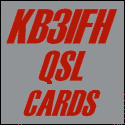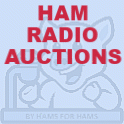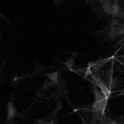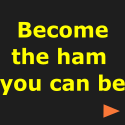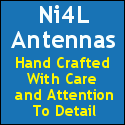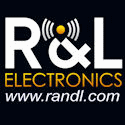Posts Tagged ‘amateurradio.com’
 There are almost as many GMRS licenses as Techs…
There are almost as many GMRS licenses as Techs…
At a recent local hamfest, my ARRL Section Manager, Malcolm W5XX, held the annual ARRL Forum. As Division Director David Norris K5UZ was giving his update on the recent Board of Directors meeting. W5XX commented that a club in North Georgia had begun reaching out to licensees of the General Mobile Radio Service (GMRS). Why? There are some 8,000 of them in surrounding counties! Give a statistician a number like that and it’s catnip to a cat.
I had heard of GMRS and the lighter-weight Family Radio Service (FRS) as additional radio frequencies to the famous Citizen’s Band (CB) that I used as a teen. But I didn’t really know much about it. So, I spent parts of a week doing some searching, reading, and, inevitably, database building. I saw the wisdom of the club in question reaching out to this audience. Let’s do a thought experiment to flesh this out.
GMRS licensees use radios up to 50 watts on mobile stations and 15 watts in fixed stations in the mid-400 mhz region. There are limitations on the type of one-way communications (no whistling which would rule out most anyone in amateur radio tuning up an amplifier, lol). But in general, there are parallels to GMRS operators to those holding a Technician license in the Amateur Radio Service with the latter having much greater frequency access, power usage, and other aspects of the radio arts.
After doing some reading, I checked the FCC ULS GMRS license data. There’s an interesting comparison: the ARRL February 2023 numbers show 386,122 Technicians while individual GMRS licenses total 336, 513 after APO addresses and one Canadian are removed. Organizations and some other groups can obtain GMRS licenses. Roughly, there are about as many individual GMRS licensees as there are Technicians, give or take 50,000. Ok, I thought, this is surprising but how do they operate? Are they communicating amongst themselves as ham operators do? How many GMRS repeaters are there? The surprises just kept on coming!
The popular site, RepeaterBook.com, does list some GMRS repeaters. But the mother ship is the myGMRS.com website. One has to have a GMRS license to register but there ‘s enough information available to the public to show just how organized parts of the GMRS community already is. I’ve taken a screenshot of the map display, nicely done with clustering repeaters until a certain zoom level is reached, showing the GMRS repeaters in the U.S. Note those in Puerto Rico: I had recommended that the ARRL assist in getting a permanent repeater on the westernmost mountains near Mayaguez after a devastating hurricane. Perhaps even an HF ALE type station directed at Florida or North Carolina. Looks like the GMRS community has done some work here, too.
The map below illustrates the set of repeater hubs and their links around the U.S. There are national and regional Nets held regularly. An audio stream can be monitored using the website for each hub, not unlike Hoseline for the Brandmeister DMR Network. Hmm. If ham radio were only this organized, so quickly.

After downloading the February 2023 GMRS data from the FCC ULS ftp site, I processed it and filtered out the overseas military licenses. These records were then georeferenced to street addresses, with some that did not have street addresses geocoded to zip codes and a few to city centroids. The map below illustrates this: the GMRS individual license IS a compelling market for amateur radio recruitment.
It’s easy to see that the North Georgia region is part of the Appalachian Mountain range that is covered with GMRS licensees But so is most of the region east of the Mississippi River, the West Coast and the mountainous areas of the Southwest. Here’s another view zoomed in to the ARRL Delta Division where I live. Licensees in GMRS tend to follow population centers but note the areas, like Nashville, where the topography gives more height-above-ground than others. Northwest Arkansas is another such location. Interesting patterns!
We know little to nothing about the age distribution of GMRS licensees as year of birth is not contained in the ULS database released to the public (only 18 or over). But it stands to reason that GMRS licensees are likely to have a broader age range of adoption. From perusing the names on the licenses — license holders can authorize other family members to use additional radios in this Service — there are gendered-naming patterns. More women in GMRS than ham radio? Possibly.
Some interactive maps of these data are now available over at FoxMikeHotel.com under the Maps tab.
An important note is that an unknown number of those holding GMRS licenses today also hold licenses in the Amateur Radio Service. The FRN is not contained in the GMRS data so it would take “fuzzy matching” with less than perfect results to examine this idea.
The ARRL has taken an interest in my proposed initiative to treat public libraries in the U.S. as “new served agencies” for recruitment strategies, according to Division Director David Norris K5UZ. See my two blog posts here and here. Should the GMRS licensees be viewed as another direct marketing opportunity by the ARRL?
I’ve taken the GMRS data and spatially joined the ARRL Division and Section fields to the license record using GIS. These files were then split into separate spreadsheets by Division with the Section as a separate field. I’ve put them on my public folder in Dropbox for all to retrieve should they desire. This would make it easy for a direct-mailing to GMRS licensees. In a cover letter identifying the contact info for their ARRL Section Manager, a brochure should be inserted describing the much greater options available by adding the Technician license through a VE exam. It works for some yield rates for other membership services. (Check today’s mail if you doubt this isn’t used frequently.)
It would not be inexpensive with USPS rates. But it would be directed at a market that is already known to have some interested in operating radios for communication. Perhaps it should begin with GMRS licensees in areas where there are existing repeater operations. This would be a good test case to see the yield from such a direct mailing.
What won’t work is to simply send the information “down stream,” expecting SMs to do all the heavy lifting. It simply won’t happen. The League already conducts a commercial mailing operation which is where this activity should be situated.
This would be a third recruiting rail for the ARRL, including the Teacher Institute (getting in schools), the pending (I’m told) Plant the Seed initiative for public libraries, and the direct mailing to known radio communication licensees in the GMRS arena. Recruit the Generals, anyone?
 Avoid the Loopy-ness of HF Loops
Avoid the Loopy-ness of HF Loops
In reworking a wire antenna around the edge of my shingled roofline that was installed 10 years ago as a (mostly) horizontal HF loop, I discovered a couple of things. After applying them successfully and preparing a draft of the principles, procedures and results, Don G3XTT decided to publish my work in the March issue of Practical Wireless magazine. Thomas K4SWL, Kirk NT0Z, and Scott K0MD gave me valuable advice on this journey.
One is that the current ARRL Antenna Book mainly parrots the wisdom of “just use 450-ohm ladder line and you’ll be fine.” Usually. OK, that’s the Cliff Notes version and they do have more to say than that. But they repeat that Philosopher of Knoxville, Larry Cebik, in his well done set of antenna models for HF loops as the main source of this wisdom. L.E. Cebik, to the surprise of many hams, was not an engineering faculty member at the University of Tennessee but a Professor of Philosophy. A good one at that.
The new English translation of Rothamel’s Antenna Book had references! It’s a more thorough and deep-dive treatment of HF loop antennas. It’s “grounded” in the published literature which “bonds” things together in terms of the reader’s comprehensive of what has been published about these HF antennas. (Sorry for the Ward Silver puns here!)
A second is that the problem with doing what most antenna texts say, measure the impedance of an antenna at the feed point, is that the loop needs to be up in the air where it’s going to be installed. This is a far climb on a ladder with an antenna analyzer!
It dawned on me that the new era analyzers with bluetooth connectivity that are light weight offer a way to measure the feed point impedance at the “bare wire” ends of the loop while keeping one’s feet on the ground. Here I am on a step ladder with my Rig Expert Stick Pro with a banana plug adapter to the bare wire ends of a loop being installed at Clay AC5Z’s house among four tall pine trees. I’m making sure that my iPhone has a good bluetooth connection to the analyzer before I attached the second bare wire end to the banana plug and let AC5Z hoist it up to it’s intended height above ground.
We used Clay’s IC-7300 set at the lowest power output (5w) to run a WSPR beacon for 12 hours on most HF bands. Below are displays from WSPR.Rocks for the fundamental 80M band (pounding Eastern Europe over night!), 20M (Europe, Australia and vicinity, Hawaii) and the 10 & 12M bands (getting to Australia and Japan).



This particular loop is nearing our final optimization. It can be optimized a bit more by raising the balun wind from 4:1 to 6:1 and taking about 3 feet off of the bare wire. This should situate the 80M band to Clay’s liking and bring the higher harmonics more into line with those bands, too. It seems to be working from the test phase.
I’ll cover it and perhaps another one being planned for Mike N5DU’s house soon. Read about the process I’m using in the March issue of Practical Wireless magazine. I cover it in detail for the loop at my HOA-based residence that didn’t just follow the conventional wisdom. It got a much improved optimization. Even being matched to 160 meters for an 80 meter fundamental design frequency!
 CQ Magazine Article on Sherwood Tools
CQ Magazine Article on Sherwood Tools
In the January 2023 issue of CQ Magazine, there is an article I wrote introducing my Sherwood Tools page over at FoxMikeHotel.com. Didn’t make the cover but it is on page 50! It will introduce the reader to these new tools to further utilize Rob Sherwood NC0B’s test suite of bench measurements on over 50 years of radios. I appreciate Rich Moseson (CQ Editor) for wanting to further publicize these online tools that I’ve created with the significant assistance of Rob Sherwood NC0B. He is an international treasure to the amateur radio community!
I update this webpage as I’m able to digest and process new data from Rob’s Table. It does take some time for me to reanalyze these data segments, as even one new entry alters the patterns and analysis from the previous dataset. If I am in the midst of other matters, it can take me a month or more to get to this update. (Amateur radio is a hobby, not a lifestyle, for me, lol.)


This work on price, performance and satisfaction with HF radios has been very popular over the past couple of years as I’ve given many talks to groups via Zoom on the studies and results. The first results from this line of research was published by (then) Editor Scott Wright K0MD at the National Contesting Journal. I’ll be adding the latest Yaesu HF radios (FTDX10 and FT-710) to the mix soon.
Stay tuned because I’m completing the analysis of a subset of these modern transceivers that includes composite transmit noise base upon data from a group of European amateurs complemented with measurements by Rob Sherwood NC0B. I’m completing that work and associated manuscript in the coming weeks.
 RAC Survey 2022 now available
RAC Survey 2022 now available
Dave Goodwin, VE3KG, RAC Regulatory Affairs Officer at the Radio Amateurs of Canada, has just posted the results of the 2022 RAC Survey on their website. It was my honor to work with RAC to analyze the data and draft the technical report. The executive team at RAC is a delight to work with: they just want to get the best answer from the data. That’s what every organization should desire so that effective policy can be made. That is why I volunteered a considerable amount of my time to work with this team.
The map above depicts amateurs in the current Canadian database of certifications (licenses), regardless of when it was granted. Thus, there are likely many Silent Keys represented in the map. But it is the universe that must be the starting point. They are quite spatially concentrated, no? But they are no doubt conversely as diverse as hams are in other countries as well. This means we must have solid, reliable data in order to make the optimal policy recommendations on their behalf. RAC takes this mission to heart.
The issues surrounding call signs in Canada is the focus of the 2022 RAC Survey. I invite you to use the links above to take a look, or even a careful reading, of the technical report. Dave Goodwin put a good Canadian spin on my Americanized spelling and offered questions that help any statistician improve a draft report. Otherwise, David and Phil McBryde VA3QR, RAC President, left the analysis to me, a professional survey researcher and statistician.
The Regulatory Team at RAC consists of Dave Goodwin, VE3KG, Paul Coverdale, VE3ICV, Bryan Rawlings, VE3QN, Glenn MacDonell, VE3XRA, Richard Ferch, VE3KI and Serge Bertuzzo, VA3SB. They have done great work here! I look forward to other collaborations with RAC. You can find out more about this team’s efforts on behalf of amateur radio in Canada at their YouTube presentation embedded below.
And, oh, I just renewed my RAC membership for 2023! I encourage you to do the same.
 Rothamel’s Antenna Book: An Authoritative Source
Rothamel’s Antenna Book: An Authoritative Source
As an academic researcher, the term “authoritative source” is reserved for works deemed to be the standard by which other scholarship in an area is judged. As a U.S. ham, I’ve purchased the ARRL Antenna Book (both new and used) since I’ve been licensed. Good reading and reference. It’s been a go-to document not only for me but for many State-side hams. There is a new Sheriff in town.
I’ve read about Rothammel’s Antenna Handbook in other publications—Practical Wireless and RadCom, for instance—but it was in German. Alas…Ich spreche kein deutsch! Since 2019, there is an English translation.
On eHam, there is but a single review. James AD0YO says, “This book is amazing! It should be on the desk of any ham interested in antennas. And, that should be all of us. The first 270 pages cover theory. The rest cover all types of antennas.” OK. James loves it. What about others?
A website I often read, the Reeve Observatory near Anchorage AK, has a review: “The information in Rothammel’s Antenna Book appears to be taken from both amateur and professional literature and patents from around the world. Having this book generally will save readers considerable time when looking for details on a particular antenna type or for ideas on what antenna to build for a certain
application. Each chapter has an extensive list of references, so it may be possible to get to the original source document.”
The popular commercial vendor in the U.S., DX Engineering, carries this volume (although out of stock as I write this). It also has only a single review. Two years ago, Juan (no call) wrote, “This is a 1,600 (page) treatise on Antennas! It is more theoretical than the ARRL Antenna Book, but quite less than John Kraus classical textbook. It has a ton of data and practical information. It is a very good comprehensive reference book on antennas.” Another onesy but rave review. No gotchas yet.
Another source I enjoy, Radio User magazine, had this announcement. “The famous Rothammel’s Antenna Book is now, at last, available in English. At the 2019 Hamvention, DARC announced the availability of the wonderful Rothammel’s Antenna Book into English. This translation is of the 13th edition of Rothammels Antennenbuch.” Now I recall my friend, Scott K0MD, telling me that he picked up a copy of this impressive book at Hamvention. Great international reviews. A close friend who bought it and is impressed. Wow! This is getting close to my wallet.
The standard ham radio antenna reference.
James AD0YO, eHam Review
Rothammel. Who is (was) this guy? Wikipedia advises “was” is unfortunately the correct tense as he is now a Silent Key (1914–1987). After reading a short biography on Rothammel, it strikes me that he would be in league with Lawrence Cebik W4RNL, a professor of philosophy at the University of Tennessee in Knoxville, long revered for his antenna work and writing. From the German Wiki, translated to English by Google Translate:
“Rothammel had been a radio amateur since 1932 with his call sign “DE3040/L”. During World War II he served as an Air Force radio operator. Little is currently known about his stay after the war, except that he settled in the Soviet occupation zone – the later GDR.
After the war, he initially worked as a guest and farmer before moving to the postal service of the GDR for ten years. At the post office, he looked after the radio and television transmission systems. After ten years, Rothammel moved to the information and documentation center at the radio equipment factory Stern-Radio in Sonneberg, which later became VEB Stern-Radio Sonneberg . He did this job for 25 years until he retired. Since 1954 Rothammel was active as a radio amateur under the call sign “DM2ABK”, since 1980 under the call sign “Y21BK” or “Y30ABK”.
In addition to his professional activities at the post office and at VEB Stern-Radio, Rothammel was a long-time club station manager in Sonneberg, a member of the examination committee in the Suhl district and an authorized person for the radio performance badge in gold. For five years he wrote articles on VHF topics for the magazine Funkamateur. In addition, he contributed as an author to various publications on the subject of radio, for example the books “Ultra Short Waves”, “Practice of TV Antennas Part 1 and 2” and the “Handbook for Short Wave Amateurs”, etc.”
I ordered a copy of the 1st Edition English translation, copyrighted in 2019, directly from the DARC. Easy order. It took several weeks to arrive via DHL and final delivery by the US Postal Service. I was researching HF loop antennas for an article. I was thrilled at the depth of coverage and the detailed citations and patents included. It greatly helped me organize my thinking on how to improve the design and deployment of an HF horizontal loop antenna. More on that article in the near future as it nears publication in Practical Wireless magazine.
Here’s an illuminating example on a relatively unknown niche type of antenna. Here in the States, due mostly to posts on QRZ.com, the reader would conclude that fractal antennas were wholly invented by Nathan W1YW. As the sportscaster Lee Corso is fond of saying, “not so fast!”. Look at what I read on pp. 948-9:
In the same year (1995), two researchers filed patent applications for something they called, fractal antennas. In May, Dr. Carlos Puente in Spain filed his application which was approved in 1998. Later, in August, Dr. Nathan Cohen filed his patent application in the United States but it was not granted until 2000. As Rothammel states, the priority goes to the first filing. This small point may only matter on legal issues but it’s both enlightening and historically correct for the amateur radio community to know that there were indeed two “inventors” of the fractal antenna line. Lots of good stuff like this in the Rothammel Antenna Book.
So does this book replace the need for the very popular Antenna Handbook by the ARRL? Not at all, as the ARRL book is geared more toward pedagogy and far less on being an authoritative reference. Rothammel’s book, for instance, does not include supplementary software, data files (antenna models, propagation projections, etc.), and such. Editions of the ARRL book do overlap greatly across adjacent editions so that’s caveat emptor for the buying ham. Me? I have quite a number of the ARRL Antenna Handbooks, as well as most things written by Joe Carr and other antenna scholars. Now, the Rothammel’s Antenna Book is on my bookshelf right beside them. I won’t have a problem finding it at 1,600 pages in length!
I can add my own superlative review to those quoted above. It’s not been fully read thus far but the spine and pages are certainly creased quite a bit! I’ve read deeply on loop antennas and through the theory section. It’s now my authoritative resource for amateur radio antennas.
 Take a Long Hard Look at Our Community… An Editorial by Onno VK6FLAB
Take a Long Hard Look at Our Community… An Editorial by Onno VK6FLAB
This post is to lift up the recent editorial published on eHam.net by Onno VK6FLAB in Australia. His long running podcast, Foundations of Amateur Radio, is one of my favorites. I listen to it every time it drops in my podcast catcher. I’m slowly making my way through the previous 500 episodes. Not one has been disappointing. Onno has recently taken on the scourge of social bullying in our hobby. It affects everyone, not just the bullied.
Once the collective atmosphere of a group, however large or small, has become contaminated by the blind or even oblique tolerance of bullying behavior by even one member of the group, it is there for all to be potentially subjected. The tolerance of bullying will precede new members and succeed former ones. While “bad character” may be the original culprit, the social norms of the group become the active agents of that tolerance of it in the future.
To be clear, our community is a welcoming environment, filled with hope and joy, but there is a small rotten element in our midst that we need to rip out root and branch, much like we would if it was deliberate HF interference.
Onno VK6FLAB on eHam.net
Onno’s essay at eHam.net is available through the link below. I encourage you to read it with an open mind as to your own behavior and those with whom you associate. Being bullied through social media tends to begat your own negative response. I wish I could state that I have never responded in that way. But I cannot. My commitment is to reduce any such behaviors in response to those engaged in bullying of me and to defend those being bullied.
As a professional sociologist who has studied social movements, almost always involving violence, I wish that I could offer a complete answer to the problem. But I do know that Onno is on the right track: tolerance of the problem will only exacerbate it. If you value the amateur radio hobby, it is worth your time and consideration to see what Onno has to say.
To read Onno’s editorial at eHam.net, click HERE.
 Visiting Again with the Denby Dale Amateur Radio Society
Visiting Again with the Denby Dale Amateur Radio Society
Have you ever been invited to visit with a group of radio amateurs and just felt like you’d dropped in at home? I’ve had the pleasure of that a few times. One of those groups is the Denby Dale Amateur Radio Society in England. Their Chairperson is Nick Bradley G4IWO. He’s invited me to natter about with the DDARS several times over the past couple of years. Last week, I spoke to them about my RadCom articles with Dr. Scott McIntosh that appeared this summer.
The talk is now on their Youtube Channel below. I hope they get back soon to meeting in Pie Hall, where they are served pie and peas. After all, Denby Dale is the home of the world’s largest meat pie! If the pie is as welcoming as the group that typically meets there, it’s very good indeed!













